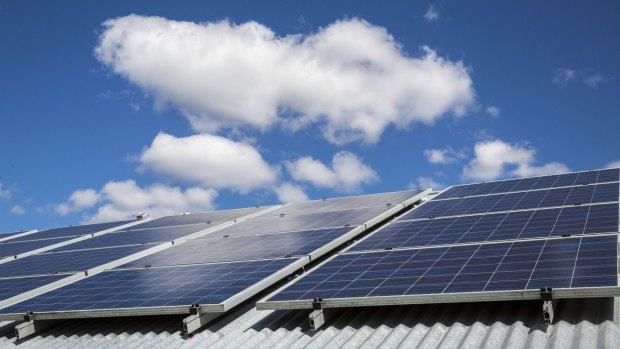Many readers have seen the commercial featuring Ray and Evon, the sun-stealing grey nomads who park their campervan outside your house and nick your solar energy. The message is, don't waste your roof by not having a solar panel.
The great irony is that the commercial promotes limitless solar power for a company which has traditionally relied on selling electricity sourced from scarce fossil fuels. That company and its competitors recognise a momentous shift in consumer behaviour is occurring and accelerating.

Solar today contributes only about 2 per cent of Australian electricity.Credit: Glenn Hunt
Solar today contributes only about 2 per cent of Australian electricity and wind 4 per cent, versus 73 per cent for coal and 13 per cent for slightly cleaner gas. But should technological advances and government policies allow, that carve-up could be reversed in a few decades. If so, Australia would have made a significant contribution to tackling global warming.
Like Ray, Evon, most Australians and many foreign governments, the Herald aspires to this sharply increased reliance on renewable energy. Many of us already do our bit through rooftop panels or solar hot water and would readily do more given the right incentive. Some of us pay a bit extra for electricity drawn from wind turbines, hydro projects or large-scale solar farms, too.
As technology improves and the share of renewables in the power grid increases, these sources will become cheaper and less reliant on government subsidies. When increasingly under the control of individual consumers rather than governments or power network companies, these more plentiful energy sources will threaten the business model of every organisation that makes money from scarce fossil fuels.
Moreover, renewable-empowered consumers won't accept climate policy scare campaigns from politicians.
But barring unforeseeable rapid progress on energy efficiency and associated cost reductions, any renewables policy must work in tandem with a market-based mechanism that prices carbon. This maximises the chance of using the most efficient technology – based on renewables or otherwise – to meet emission reduction targets. As such it offers the most bang for the buck of taxpayers and consumers.
In a perfect world Australia would be proposing a market-based solution and greater focus on renewables to the Paris climate talks in late November. But missteps and cynical politics have left the political environment so poisonous that any market mechanism is liable to be branded a carbon tax.
The most politically palatable alternative is to appeal to the household penchant for renewables.
Under fire over a leaked commitment to an emissions trading scheme, Labor leader Bill Shorten last month responded with a populist 50 per cent aspiration for renewables by 2030. The existing bipartisan goal for renewables – the Renewable Energy Target – has been reduced to the equivalent of 23.5 per cent by 2020. But if present trends in renewables usage continues, Labor's new goal a decade later is still doable – although it has not revealed how it plans to reach the target.
Voters like renewable energy because they feel they are contributing to a solution. They understand that prices rise for renewable energy in the early years – albeit not by as much as the Abbott government claims of Labor's 50 per cent target. Crucially, voters know the average cost of renewables drops later as the installation outlay is offset by lower prices because renewables, unlike fossil-fuel energy, do not require ongoing outlays for scarce inputs.
The Abbott government, by contrast, will rely less on renewables and more on paying polluters to reach its emissions reduction targets. While number-fiddling might make it look like Direct Action can achieve them, to meet more ambitious goals the policy will have to pay polluters more taxpayers' money or penalise those who increase emissions to wipe out gains elsewhere. That would in effect require a much stronger safeguards mechanism – potentially creating a baseline and credit market mechanism, as the Herald has urged. But the government has now rejected such a move, presumably because it could elicit cries of "carbon tax".
There is always a price to pay for reducing greenhouse gas emissions. Take away the political scare campaign, though, and voters have a real choice. They can pay slightly more now through more renewables and a market-based carbon price – or they can pay a much higher price later.